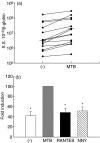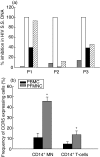Inhibition of human immunodeficiency virus-1 (HIV-1) by beta-chemokine analogues in mononuclear cells from HIV-1-infected patients with active tuberculosis
- PMID: 16232220
- PMCID: PMC1809505
- DOI: 10.1111/j.1365-2249.2005.02913.x
Inhibition of human immunodeficiency virus-1 (HIV-1) by beta-chemokine analogues in mononuclear cells from HIV-1-infected patients with active tuberculosis
Abstract
Tuberculosis (TB) enhances human immunodeficiency virus-1 (HIV-1) activity in patients with dual HIV-1/TB infection. Therapies that control augmentations of HIV-1 activity at sites of Mycobacterium tuberculosis (MTB) infection may be useful in inhibition of viral expansion. Regulated upon activation, normal T-cell expressed and secreted (RANTES) analogues (AOP and NNY) are potent in inhibiting the entry of primary HIV-1 isolates into host mononuclear cells. These analogues were used to inhibit MTB-induced HIV-1 entry in blood monunuclear cells (PBMC) from patients with pulmonary TB, and pleural fluid mononuclear cells (PFMC) from patients with pleural TB. PBMC or PFMC were cultured with and without MTB in presence and absence of RANTES analogues. HIV-1 strong stop DNA was assessed by real-time polymerase chain reaction (PCR) as a measure of infection. CCR5 mRNA was assessed by real-time reverse transcription (RT)-PCR and by immunostaining and FACS analysis. HIV-1 infection was induced by MTB in vitro in PBMC from the majority (14 of 20) of HIV-1/TB subjects, and new infection was inhibited by AOP- or NNY-RANTES. HIV-1 infection was also inhibited by these reagents in MTB-induced PFMC from three of three patients with pleural TB. Expression of CCR5 mRNA was significantly induced by MTB in PBMC from patients with pulmonary TB. Further, expression of CCR5 was higher in PFMC compared to PBMC from patients with pleural TB. Also, CCR5 was fourfold higher on CD14(+) pleural mononuclear cells than on CD4(+) lymphocytes. Blocking new HIV-1 infection of mononuclear cells may be useful in control of HIV-1 during dual HIV-1/TB infection.
Figures

 ), and in PBMC cultured with medium alone (□) were compared to MTB-induced PBMC (
), and in PBMC cultured with medium alone (□) were compared to MTB-induced PBMC ( ) (considered as 100%). Data presented are from 10 of 14 subjects who had inhibition by RANTES analogues. *P < 0·05.
) (considered as 100%). Data presented are from 10 of 14 subjects who had inhibition by RANTES analogues. *P < 0·05.

 ), or with media alone (−) (
), or with media alone (−) ( ). HIV SS DNA was assessed and expressed as a percentage of SS DNA in MTB-stimulated PFMC (given 100%) in each individual. Inhibition in HIV-1 SS DNA in the presence of AOP and NYY-RANTES was expressed as a percentage of SS DNA in the presence of MTB alone. (b) Expression of CCR5 on CD14 (left) and CD4 (right) PFMC (
). HIV SS DNA was assessed and expressed as a percentage of SS DNA in MTB-stimulated PFMC (given 100%) in each individual. Inhibition in HIV-1 SS DNA in the presence of AOP and NYY-RANTES was expressed as a percentage of SS DNA in the presence of MTB alone. (b) Expression of CCR5 on CD14 (left) and CD4 (right) PFMC ( ) and autologous PBMC (▪) from nine HIV-1/TB patients was assessed by immunostaining and FACS analysis. **P < 0·001; *P < 0·05.
) and autologous PBMC (▪) from nine HIV-1/TB patients was assessed by immunostaining and FACS analysis. **P < 0·001; *P < 0·05.Similar articles
-
Activation of beta-chemokines and CCR5 in persons infected with human immunodeficiency virus type 1 and tuberculosis.J Infect Dis. 2001 Jun 15;183(12):1801-4. doi: 10.1086/320724. Epub 2001 May 17. J Infect Dis. 2001. PMID: 11372034
-
Distinct cytokine and regulatory T cell profile at pleural sites of dual HIV/tuberculosis infection compared to that in the systemic circulation.Clin Exp Immunol. 2011 Mar;163(3):333-8. doi: 10.1111/j.1365-2249.2010.04269.x. Clin Exp Immunol. 2011. PMID: 21303360 Free PMC article.
-
Immune Activation at Sites of HIV/TB Co-Infection Contributes to the Pathogenesis of HIV-1 Disease.PLoS One. 2016 Nov 21;11(11):e0166954. doi: 10.1371/journal.pone.0166954. eCollection 2016. PLoS One. 2016. PMID: 27870882 Free PMC article.
-
PSC-RANTES blocks R5 human immunodeficiency virus infection of Langerhans cells isolated from individuals with a variety of CCR5 diplotypes.J Virol. 2004 Jul;78(14):7602-9. doi: 10.1128/JVI.78.14.7602-7609.2004. J Virol. 2004. PMID: 15220435 Free PMC article.
-
Virological and immunological impact of tuberculosis on human immunodeficiency virus type 1 disease.J Infect Dis. 2003 Oct 15;188(8):1146-55. doi: 10.1086/378676. Epub 2003 Sep 30. J Infect Dis. 2003. PMID: 14551885 Review.
Cited by
-
Induction of HIV type 1 expression correlates with T cell responsiveness to mycobacteria in patients coinfected with HIV type 1 and Mycobacterium tuberculosis.AIDS Res Hum Retroviruses. 2009 Feb;25(2):213-6. doi: 10.1089/aid.2008.0182. AIDS Res Hum Retroviruses. 2009. PMID: 19239361 Free PMC article.
-
Impaired plasmacytoid dendritic cell (PDC)-NK cell activity in viremic human immunodeficiency virus infection attributable to impairments in both PDC and NK cell function.J Virol. 2009 Nov;83(21):11175-87. doi: 10.1128/JVI.00753-09. Epub 2009 Aug 19. J Virol. 2009. PMID: 19692459 Free PMC article.
-
Broad antiretroviral activity and resistance profile of the novel human immunodeficiency virus integrase inhibitor elvitegravir (JTK-303/GS-9137).J Virol. 2008 Jan;82(2):764-74. doi: 10.1128/JVI.01534-07. Epub 2007 Oct 31. J Virol. 2008. PMID: 17977962 Free PMC article.
-
HIV-MTB Co-Infection Reduces CD4+ T Cells and Affects Granuloma Integrity.Viruses. 2024 Aug 21;16(8):1335. doi: 10.3390/v16081335. Viruses. 2024. PMID: 39205309 Free PMC article.
-
Targets of small interfering RNA restriction during human immunodeficiency virus type 1 replication.J Virol. 2008 Mar;82(6):2938-51. doi: 10.1128/JVI.02126-07. Epub 2008 Jan 16. J Virol. 2008. PMID: 18199654 Free PMC article.
References
-
- Whalen C, Horsburgh CR, Hom D, Lahart C, Simberkoff M, Ellner J. Accelerated course of human immunodeficiency virus infection after tuberculosis. Am J Respir Crit Care Med. 1995;151:129–35. - PubMed
-
- Nunn P, Brindle R, Carpenter L, et al. Cohort study of human immunodeficiency virus infection in patients with tuberculosis in Nairobi, Kenya. Analysis of early (6-month) mortality. Am Rev Respir Dis. 1992;146:849–54. - PubMed
MeSH terms
Substances
Grants and funding
LinkOut - more resources
Full Text Sources
Medical
Research Materials

